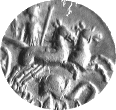
CADERIGE/CADIXE
Special Features of CADIXE
The “EMPTY” tags
EMPTY tags (for instance a tag such as </BR> in XHTML) are special tags of the DTD whose goal is not to annotate a fragment of text but to introduce some local information in the document. These tags are displayed as icons. The icon (GIF image) to use for a given tag is given in the tag style (cf “Creation of Style Sheets”). Here is an example of display :
![]()
Of course to insert this kind of tag it is not necessary to select a fragment of text as with the other tags. However, if a fragment is selected the EMPTY tag is inserted at the end.
Notion of “Comments”
With CADIXE, the user can associate a comment to each tag inserted in the document. This comment allows one to express the meaning of an annotation and/or his/her doubts and queries about it. This feature is interesting as soon as the annotation task can spend a long time and/or can involved several different annotators. A comment is organized in two parts :
- A text field in which the user can provide explanations.
- A “status” whose value is among : {validated, unvalidated, erroneous}.
Tags having a comment are displayed in the XML panel with a specific icon whose color mirrors the status. These notes are stored in the XML file as a comment “<-- ... -->“ (in the XML meaning of the term) that are interpreted by CADIXE during loading process. This information therefore doesn’t change the congruity of the document with respect to the DTD. To add (or modify) a comment associated to the current tag, there are three ways :
- To call the command “Add comment” from TAG menu.
- To do a double click in the column “comment” of the tag in XML zone.
- To activate the display of the “comment tool” in the right part of the editor. In that case the command “Add comment” is automatically inactivated.
When the dialog box (or the tool) is displayed, the user can navigate between the comments thanks to a set of three colored pairs of buttons. “Black” ones allow to go to the next/previous comment, “Orange/red” one allow to go to the next/previous comment having a status either “unvalidated” or “erroneous”, and “Red” ones allow to navigate between the “erroneous” comments only.
Finally, the Reset button (the crossed “C”) suppresses the current comment : the status becomes “validated” and the text field is emptied
Parametric styles
With CADIXE it is possible to associate several style definitions to a given tag, the selection of the style being dynamically done according to the value of one or several attributes. This feature allows to graphically telling apart a set of information having the same semantic without the need of multiplying the number of tags described in the DTD.
We are going to illustrate this feature with a simple example. Let us imagine we have in a (biological) DTD a tag named <INTERACTION> with an attribute ROLE that can take two different values : ACTIVATE and INHIBIT. If the user wants to have two different display styles for this tag according to the value of ROLE, he/she just have to put the following lines in the CSS styles (see also “Creation of style sheets”) :
- First we need to point out that the style associated to the tag INTERACTION is “specialized” by the value of ROLE. This is achieve by adding the attribute CADIXE-index-attribute in the definition of this style :
- .interaction { … CADIXE-index-attribute : role ; … }
- Then we create in the CSS file two new styles by concatenating the name of the tag with each of the value taken by ROLE. Tag name and value identifier must be separated by an underscore (“_”). In the hereunder example the variation concerns the color of the text but any other modification is feasible.
- .interaction_activate { … color : red ; … }
- .interaction_inhibit { … color: blue ; … }
The two new styles will be automatically used by CADIXE according to the value filled in ROLE, the display will be the following :
|
Tag in the annotated document Display
|
Display
|
| <interaction role=“activate”> Gene Abc </interaction> | Gene Abc |
| <interaction role=“inhibit”> Gene Abc </interaction> | Gene Abc |
If the user would like to specialize the display with several attributes he/she just have to put a list of attributes in CADIXE-index-attribute (separated by a comma) and to create has many new styles that the number of possible combination of values.
Looking at the annotated document on the WEB
It is possible to show an annotated document with a “standard” WEB browser as soon as it is able to deal with the CSS style sheets in a XML document (that’s the case for instance of FireFox, Safari, …). Indeed, when a document is saved in CADIXE the following line is automatically inserted in the file header :
- <?xml-stylesheet type=“text/css” href=“XXX.CSS”?>
The name XXX.CSS is the one of the current style sheet. Therefore by copying this file in the same folder than the document, any user can load and display the document on the WEB.
Caution: as the annotated document are “pure XML”, to display a “Carriage Return” between some of the tags, one need to add the attribute “display : block;” in their style descriptions. Moreover, to improve the aspect of the document, it is interesting to insert some attributes such as “padding : numberpx;” and “vertical-align : numberpx;”. Adding these attributes is not a problem for CADIXE since there are currently ignored.